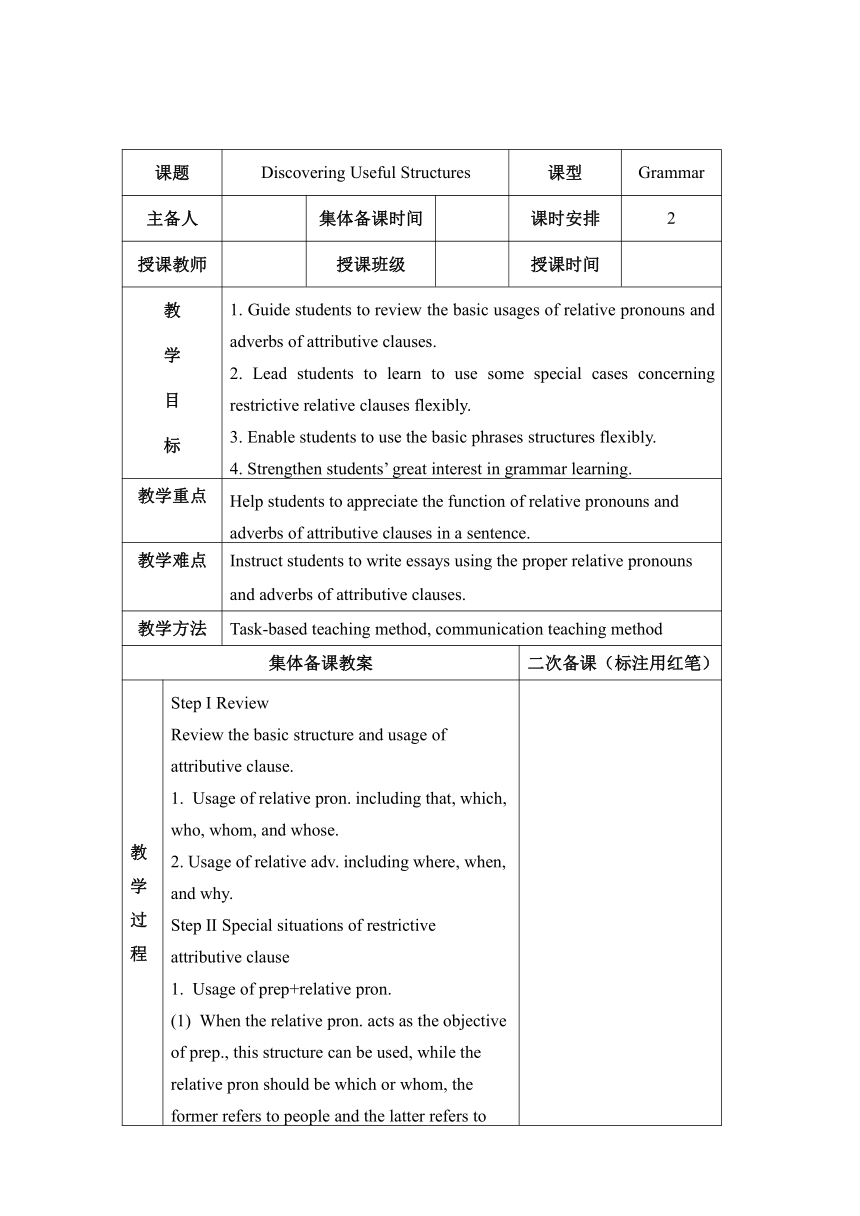
课题 Discovering Useful Structures 课型 Grammar 主备人 集体备课时间 课时安排 2 授课教师 授课班级 授课时间 教 学 目 标 1. Guide students to review the basic usages of relative pronouns and adverbs of attributive clauses. 2. Lead students to learn to use some special cases concerning restrictive relative clauses flexibly. 3. Enable students to use the basic phrases structures flexibly. 4. Strengthen students’ great interest in grammar learning. 教学重点 Help students to appreciate the function of relative pronouns and adverbs of attributive clauses in a sentence. 教学难点 Instruct students to write essays using the proper relative pronouns and adverbs of attributive clauses. 教学方法 Task-based teaching method, communication teaching method 集体备课教案 二次备课(标注用红笔) 教学过程 Step I Review Review the basic structure and usage of attributive clause. Usage of relative pron. including that, which, who, whom, and whose. 2. Usage of relative adv. including where, when, and why. Step II Special situations of restrictive attributive clause Usage of prep+relative pron. When the relative pron. acts as the objective of prep., this structure can be used, while the relative pron should be which or whom, the former refers to people and the latter refers to 教学过程 things. Confirmation of the prep According to the collocations of verbs or adjectives. According to the meaning of antecedent. According to the meaning of whole sentence. The word “of” should be used to represent the part of the entirety. Some verb phrases cannot be divided to use in attributive clause such as look after, look for... Step III Common sentence structures pron+ of + which/whom In this situation, pron are “all, each, one, many, much, most, some, none, both etc.” number+of + which /whom the+n.+ of which/whom the+adj. Comparative degree(the superlative degree)+ of + which/whom Step IV Omit the relative pron. The antecedent acts as the objective in the attributive clause. The antecedent is “way, reason, time, place” which are adverbial parts in the attributive clause, in this case the relative words “that/in which, why/that, when, where” can be omitted. In the case there is one antecedent with two attributive clauses, the first relative words can be omitted, but the second or the third one cannot. Step IV Practice 填入适当的“介词+关系代词”使句意完整。 1. He is the man _____ _____ you can rely. 他是你可以信赖的人。 2. Jack introduced to me his friend _____ _____ I was not very familiar. 杰克向我介绍了我不很熟悉的那个朋友。 3. I’ll never forget the day _____ _____ we worked together in the countryside. 4.我不会忘记我们一起在乡下工作的日子。The clever boy made a hole in the wall, _____ _____ we could see what was happening inside the house. 这个聪明的孩子在墙上挖了一个洞,透过它我们可以看到屋里发生的事情。 作业 Finish the task 3 of learning material. 板书 1.pron+ of + which/whom 2.number+of + which /whom 3.the+n.+ of which/whom 4.the+adj. Comparative degree(the superlative ... ...
~~ 您好,已阅读到文档的结尾了 ~~

